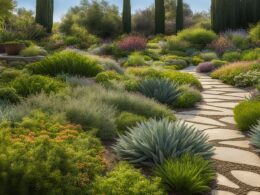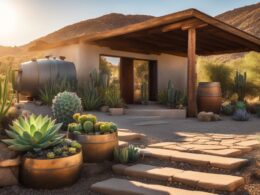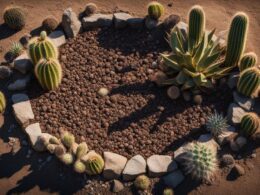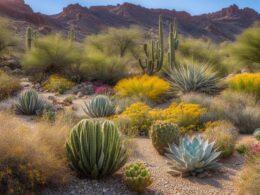Transform your garden into a low-maintenance, water-efficient oasis with our expert guide on DIY Native Plant Xeriscape Projects. Whether you’re a seasoned gardener or a beginner, this comprehensive guide will provide you with practical tips and inspiration to create a beautiful and sustainable garden.
With the increasing importance of conserving water and creating environmentally-friendly outdoor spaces, DIY Native Plant Xeriscape Projects have gained popularity. By using native plants that are adapted to your local climate, you can achieve a stunning garden that requires minimal upkeep and saves water.
Key Takeaways:
- Learn how to create a low-maintenance and water-efficient garden
- Discover design ideas for incorporating native plants into your backyard
- Get started with DIY projects to enhance your outdoor space
- Understand the planning process and practical suggestions for your projects
- Select the right plants for your DIY Native Plant Xeriscape Projects
Get Started with DIY Native Plant Xeriscape Projects
If you’re looking to transform your backyard into a water-efficient and low-maintenance oasis, DIY native plant xeriscape projects are the way to go. By incorporating landscaping updates, you can create an outdoor space that not only looks beautiful but also conserves water and requires minimal upkeep. Whether you’re a seasoned DIY enthusiast or just starting out, there are plenty of ideas and projects to inspire you.
One popular option is to add pollinator gardens to your backyard. These gardens are not only visually appealing but also help support pollinators like bees and butterflies. To create a pollinator-friendly space, choose native plants that provide nectar and pollen throughout the season. Incorporate a variety of flower shapes and colors to attract a wide range of pollinators.
If you’re looking to enhance your outdoor living experience, consider adding walkways and paths to your garden. This not only adds functionality but also creates an inviting atmosphere. You can use materials like gravel, pavers, or natural stones to create unique pathways that lead to different areas of your backyard oasis.
Table: DIY Yard Projects for Your Backyard Oasis
| Project | Description |
|---|---|
| Building a Certified Wildlife Habitat | Create a habitat that attracts wildlife by incorporating native plants, bird feeders, and water sources. |
| Sprucing Up Your Side Yard | Transform your often-overlooked side yard into a functional and beautiful space with landscaping and hardscape features. |
| Building a Fire Pit | Add warmth and ambiance to your backyard with a DIY fire pit. Gather around the fire with friends and family for cozy evenings. |
| Creating a Gravel Patio | Add a stylish and low-maintenance outdoor seating area with a gravel patio. Customize the size and shape to fit your space. |
Furthermore, mulching your garden is an effective way to retain moisture and suppress weed growth. Organic mulches, such as wood chips or bark, not only improve soil health but also add a polished look to your landscape. Spread a layer of mulch around your plants to conserve moisture and reduce the need for frequent watering.
Remember, DIY native plant xeriscape projects are about creating a space that suits your style and needs. Don’t be afraid to get creative and think outside the box. With a little planning and some DIY skills, you can turn your backyard into a beautiful and sustainable outdoor retreat.
Planning Your DIY Native Plant Xeriscape Projects
When embarking on your DIY Native Plant Xeriscape Projects, careful planning is essential to ensure a successful outcome. By following a structured planning process and considering practical suggestions, you can create a beautiful and functional xeriscape garden that meets your specific needs.
Assessing Your Yard’s Purpose and Needs
Before diving into the design process, take the time to evaluate how you use your yard and identify any practical requirements you have. Consider factors such as space for outdoor dining or entertaining, children’s play areas, and storage needs. This assessment will help you determine the layout and features that best suit your lifestyle.
Lawn Conversions and Hardscape Integration
If you’re looking to conserve water and reduce maintenance, consider converting a portion of your lawn into a xeriscape garden. Start small by selecting an area that receives full sun or is challenging to irrigate. By gradually converting your lawn, you can create a sustainable and visually appealing landscape.
In addition to removing turf, incorporating hardscape elements into your xeriscape design can add structure and functionality to your outdoor space. Hardscaping features like pathways, patios, and seating areas can create focal points and define different areas of your garden.
Gathering Inspiration and Resources
One of the best ways to kickstart your planning process is by gathering inspiration from public gardens, online resources, and books on xeriscape gardening. Visiting local botanical gardens or attending garden tours can provide valuable insights into plant choices, design elements, and overall aesthetics.
Furthermore, take advantage of resources such as Colorado State University Extension, Colorado Native Plant Society, and Plant Select for guidance on plant selection and cultivation requirements. Local nurseries are also excellent sources of information and can provide expert advice on which native plants thrive in your specific region.
| Table: Planning Considerations for DIY Native Plant Xeriscape Projects |
|---|
| Assess your yard’s purpose and practical needs |
| Consider lawn conversions and hardscape integration |
| Gather inspiration from public gardens and online resources |
| Consult Colorado State University Extension, Colorado Native Plant Society, and local nurseries for guidance |
By carefully planning your DIY Native Plant Xeriscape Projects, you can create a stunning and sustainable garden that aligns with your lifestyle and conserves water. Use this planning process as a foundation for your project and don’t be afraid to experiment and adapt as you go along. The next section will delve into selecting the right plants for your xeriscape garden.
Selecting Plants for Your DIY Native Plant Xeriscape Projects
Choosing the right plants is a crucial step in your DIY native plant xeriscape projects. By selecting Colorado native plants and xeric varieties, you can ensure a successful and thriving garden that requires less water and maintenance. Here are some key considerations and resources to help you in your plant selection process:
Native Plants and Xeric Varieties
Colorado native plants are well-adapted to the local climate and soil conditions, making them more resilient and water-efficient. They have evolved to thrive in the local ecosystem and provide important habitat for native wildlife. Xeric varieties, specifically bred for their ability to withstand drought conditions, are also excellent choices for your xeriscape garden.
Plant Varieties
When choosing plants for your DIY native plant xeriscape projects, consider the different varieties available. Native trees, shrubs, and perennial grasses offer a diverse range of options to add structure and visual interest to your garden. Consulting resources such as the CSU Extension, Colorado Native Plant Society, and Plant Select can provide you with valuable information on specific plant varieties that are suitable for your area.
| Plant Type | Examples |
|---|---|
| Trees | Pinyon pine, Colorado blue spruce |
| Shrubs | Rocky Mountain juniper, chokecherry |
| Perennial Grasses | Little bluestem, blue grama grass |
Resources for Plant Selection
Take advantage of the wealth of resources available to aid you in selecting the right plants for your DIY native plant xeriscape projects. The CSU Extension provides valuable information on Colorado native plants and gardening practices. The Colorado Native Plant Society offers a directory of nurseries that specialize in native plants. Plant Select, a cooperative program, recommends specific plant varieties that are well-suited to the Colorado climate and water-wise gardening.
By choosing the right plants for your DIY native plant xeriscape projects, you can create a beautiful and sustainable garden that thrives in the challenging Colorado climate.
Designing and Maintaining Your DIY Native Plant Xeriscape Projects
Designing and maintaining your DIY native plant xeriscape projects requires careful consideration of various garden design principles, space requirements, cultivation requirements, mulching techniques, and the desire for year-round garden interest. By following these guidelines, you can create a beautiful and sustainable garden that thrives in the challenging Colorado climate.
Garden Design Principles
When designing your DIY native plant xeriscape projects, it’s important to keep in mind basic garden design principles. Consider the size and placement of your garden, taking into account factors such as soil type, sun exposure, and wind patterns. Additionally, think about the overall appearance of your garden throughout the year and how it will complement your existing landscape. Group plants together with similar water, soil, and sun requirements for efficient maintenance and to create visually pleasing arrangements.
Space and Cultivation Requirements
Assess the space available for your DIY native plant xeriscape projects and consider the practical needs you have for your outdoor space. Determine if you require areas for outdoor dining, children’s play, or storage. Keep in mind that native plants and xeric varieties often require less watering and maintenance than traditional garden plants. If you have a large lawn, you may want to consider converting a portion of it into a xeriscape area or focusing on areas that are difficult to irrigate. In addition, consider incorporating hardscape elements such as paths, steps, or patios to add structure and functionality to your garden.
Mulching and Year-Round Interest
Mulching your DIY native plant xeriscape projects is an essential step in water conservation and weed prevention. Apply a layer of organic mulch around your plants to help retain moisture in the soil and suppress weed growth. Mulch also helps regulate soil temperature, keeping it cooler in summer and warmer in winter. When selecting mulch, choose materials that are locally available and appropriate for your plants and climate. Ensure that your garden has year-round interest by incorporating plants with different blooming times and seasonal attributes. This will ensure that your garden remains visually appealing and vibrant throughout the year.
| Garden Design Principles | Space and Cultivation Requirements | Mulching and Year-Round Interest |
|---|---|---|
| – Consider size and placement of garden | – Assess available space and practical needs | – Apply organic mulch for water conservation |
| – Take into account soil type, sun exposure, and wind patterns | – Convert lawn areas or focus on difficult-to-irrigate areas | – Choose mulch that is appropriate for plants and climate |
| – Group plants with similar requirements | – Incorporate hardscape elements for structure | – Ensure year-round interest with plants of different blooming times |
By following these design principles and considering space requirements, cultivation requirements, mulching techniques, and year-round garden interest, you can create a successful DIY native plant xeriscape project that complements your landscape and thrives in the challenging Colorado climate.
How Can I Incorporate Native Plant Xeriscaping into My DIY Garden Project?
When creating a DIY garden project, consider incorporating a native plant xeriscape plan. Research native plants that are well-suited to your region’s climate and soil type. Utilize drought-resistant varieties to minimize water usage and maintenance. By implementing a xeriscape plan, you can create a beautiful and sustainable garden space.
Conclusion
DIY Native Plant Xeriscape Projects offer a sustainable and environmentally friendly approach to successful gardening in the challenging Colorado climate. By selecting and planting xeric and Colorado native plants, you can create a beautiful and low-maintenance garden that supports pollinators and wildlife.
The Plant Select program provides a wealth of recommendations and resources to help you thrive as a gardener in Colorado. Their expertise in identifying and promoting the best-performing plants for our region ensures that your DIY Native Plant Xeriscape Projects will be a success.
Embracing sustainability through the use of xeric and native plants not only reduces your water usage but also contributes to the preservation of our local ecosystem. By opting for these resilient plant varieties, you are making a positive impact on the environment and fostering a harmonious relationship between your garden and the surrounding natural habitat. Start your DIY Native Plant Xeriscape Project today and experience the beauty and benefits of sustainable gardening.












